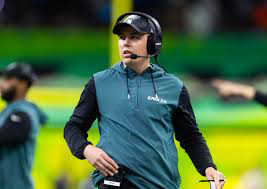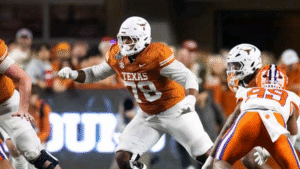
A Cautionary Tale for New Orleans: Left O-Line Could Become Achilles’ Heel
1. Exploring the Risk of Instability
The New Orleans Saints enter the 2025 NFL season with considerable optimism surrounding their offense, particularly given quarterback Derek Carr’s return and the surrounding skill pieces. Yet one area threatens to undermine their balance and momentum: the left side of their offensive line. As it stands, the team has entrusted rookie Kelvin Banks Jr. at left tackle and Trevor Penning at left guard. Individually, each player poses a different brand of mystery in terms of durability and performance. Foremost, however, is the very real possibility that both falter simultaneously—an outcome that could have severe ripple effects throughout the Saints’ offensive ecosystem.

Think of the offensive front as a defensive fortification. Having two components that are unpredictable—even mildly so—poses some risk. But when those unstable pieces are adjacent, especially on the same flank, that risk rises exponentially. Whether through broken assignments, miscommunications, or simply inadequate execution, weak spots can appear. In this case, that would leave the left flank of the Saints’ line vulnerable to pressure and collapse.
Such a shift wouldn’t just be a minor hiccup—it threatens two key operational domains: the running game and pass protection. If one side of the line can be neutralized or consistently beaten, the entire flow of play starts to tilt. Offenses work best when their threats are balanced; a compromised side forces defensive coordinators to overload one area, predict who’s carrying or where the ball is headed, or send blitzes to exploit single coverage.
2. The Domino Effect: Previewing Worst-Case Scenarios
Running Game Vulnerability
When the left flank struggles, the ground game often gravitates toward the right side—where stability and strength are assumed to reside. That predictability is anathema to offensive success in the NFL. Defenses can key in on one gap, adjust their alignments, and swarm to the line of scrimmage. The sudden shift in emphasis strips away the Saints’ ability to keep the opposition off balance, making them one-dimensional and easier to scheme against.
Passing Game Liability
Beyond the run, quarterback protection is paramount—especially on the blind side, the area a right-handed quarterback can’t see. With only Banks and Penning occupying the left guard and left tackle roles, any slip-up or mismatch could lead to a blind-side hit. Whether it’s erratic footwork, poor handling of power or speed rush, or lack of recognition for stunts and twists, a positional struggle in pass protection would put Derek Carr (or any quarterback) at risk—physically and mentally. The pressure hastens throws, sacrifices rhythm, and disrupts the timing with pass-catchers.
In short: having either Banks or Penning struggle could spell trouble. But if both underperform, the left side could become an offensive liability of the highest order. In that scenario, game-planning becomes all about damage control instead of execution. In contrast, a stable, reliable left side offers foundation and flexibility. The Saints simply can’t afford to sacrifice both sides of the argument.
Part 2: The Penning Factor
1. A Career of Moving Targets
Trevor Penning’s journey with the Saints has been anything but linear. Originally a left tackle in his early years, injury and roster needs have forced him to shift. In 2023, he was ousted from an impactful win at the combine due to knee surgery, and the next two seasons saw him split time between left and right tackle roles—each with its own nuances and challenges. As of now, Penning is being asked yet again to relocate—this time to guard. Midseason position shifts aren’t unprecedented in the NFL, but they carry risks. Transitioning from the edge to the interior presents a distinct set of technical, mental, and physical demands.
Footwork & Technique: As a tackle, Penning thrived in space—chasing speed rushers in wider arcs and setting the edge on runs. Guard is a tighter arena, where quick drops, lateral shuffle, leverage battles, and immediate recognition of blitzes and slants are non-negotiable.
Strength & Power Application: On the inside, force comes straight at you. One must hold ground against powerful interior rushers and meet linebackers at the second level. Whereas edge play is often about keeping speed off-balance, guard play demands anchor and resistance.
Mental Acuity: Guards are responsible for as many schematic adjustments as tackles—sometimes more. They must read stunts, coordinate with the center and tackle, and understand how protections shift depending on pressure. There’s simply less time to think once the ball is snapped.
Coaching support matters enormously. Mekhi Becton, formerly with the Jets, needed extra instruction from coach Kellen Moore when he switched to guard under the Eagles. That transition required time, film work, and detailed technique refinement. New Orleans is betting that Penning can replicate that success story, but there’s no guarantee.
2. The Depth Chart Signal
Even with Penning slotted at guard, Dillon Radunz—another veteran—sits behind him. That’s significant. Radunz is essentially holding the leash. If Penning falters, Radunz is the fallback. That means Penning has no room for error; underperformance means loss of snaps, and potentially his grip on the starting job entirely. Every misstep—every sack allowed, every blown assignment—could immediately impact the frontline composition. The Saints can’t hide him on the bench the same way they might redirect a rookie tackle—they need consistent play from an established veteran stepping into a new role.
Part 3: Kelvin Banks Jr.’s Rookie Equation
1. The Promise and the Unknown
Draft capital means something. Kelvin Banks Jr. came into the NFL in 2025 with pedigree and promise. He draws comparisons to other Saints rookies who succeeded early, notably defensive end Kimoni Fitilitonga (“Fuaga”), who stormed through a rookie season, battling elite rusher Myles Garrett and earning consistent playing time. But linemen—particularly rookie tackles—often encounter a steep learning curve.
Step Up in Competition: In college, even top-tier tackles face NFL-quality pass rushers only a handful of times a season. In the pros, every team has a cadre of elite athletes. First-round tackles almost always struggle early adapting to the speed, nuance, and sheer physicality.
Technique Adjustment: Rookies must refine sets, hand placement, punch timing, spatial awareness, and recovery pathways—all while absorbing new playbooks and signals. Blitz recognition, pre-snap alignment, pick-up responsibility… these are heavy weights to carry.
Physical Adaptation: Padding, pace, and length of season can take a toll. Learning to recover from bad plays, process game speed, and hang tough through four quarters—these are nontrivial developments.
2. Growth Without Devastation
It wouldn’t be a digression to expect Banks to show inconsistencies early. Most rookie tackles take games—and often mid-season—to show comfort. Inconsistent performance through the first half of the year is not a blow-up—it’s part of development. But for the Saints in 2025, each misstep could compound the pressure on Penning and the unit as a whole.
Contrast with the Becton-to-guard transition: that case involved a seventh-year veteran in a new spot. Here, you have a freshman facing off against NFL stalwarts on day one. The margin for learning mistakes is razor thin. And if Banks is forced to play out of position, it becomes even tougher. The rook must literally learn while performing—or risk stepping in mud.
Part 4: Two-Front Battle
1. Double Whammy Danger
When two uncertain linemen occupy adjacent positions, the offensive scheme becomes extraordinarily fragile:
Crowded Layers of Risk: Miscommunication, mis-alignment, breakdowns—the frequency multiplies.
Defensive Exploitation: Opponents will notice and scheme overloads or stunts through that side early.
Quarterback Anxiety: The signal-caller senses shifting protection, shortens follow-throughs, and becomes target-happy.
Rushing Collapse: Pack adjust: stop the run to the left, force it weak side, clogg the middle.
In other words: two projects side by side isn’t just additive risk—it’s exponential. The team can survive one malfunction, but rarely two.
2. Predictability Kills Creativity
Modern offenses thrive on ambiguity—where will the defense bite? Will it be run or pass? Will the QB extend or slide? But when both left guard and tackle are shaky, the answer is predictable: watch left. Schemes start there. This also telegraphs pre-snap looks. Defenders front-load, linebacker blitz, call extra pressure. The offense gets stuck looking for answers instead of making plays.
Part 5: Potential Upside & Silver Linings
Of course, the story need not end in collapse. Neither Rox nor Banks are incapable of growth and contribution. If either player, or both, exceeds expectations, the payoff is substantial—and both come with legitimate upside:
1. Penning’s Ceiling at Guard
From a technical standpoint, moving inside could suit Penning better over time. He’s bulkier than typical tackles and may benefit from a shorter kick-slide and interior leverage. His agility and footwork—once honed—could make him a serviceable, even above-average guard. If he establishes clear angles, handles power rushers, reaches secondary levels, and helps open lanes, this move could cement himself as a starter.
That’s the hope. Penning at his best enables both Carr’s comfort and the running game’s idiosyncratic moves. It reduces reliance on right-handed runs, stabilizes protection schemes, and raises the overall performance grade of the unit.
2. Rookie Bounce for Banks
Let’s not forget: first-round tackles occasionally hit the ground running. Look at Jordan Mailata or Trent Williams—they offered early success. If Banks demonstrates awareness, handles speed rushers, works through quickness and agility, shows steadiness inside, plays with posture and leverage—he could be a steal out of the draft.
Progress Tracking: Through camps, joint practices, preseason, and early games—the Saints are watching technique, consistency, and mental growth. If Banks picks up stunts quicker, improves in footwork, and controls the edge, he’ll stabilize the left side fast.
Part 6: Strategic Paths Forward
The Saints’ options if the situation deteriorates include:
Slide on the Line: Rotate guards or bring Radunz in; consider internal competition.
Roster Adjustments: Trade or sign veteran O-linemen before deadline or post-injury.
Tweak Schemes: Use chip blocks, tight ends to help; quick-passing game to offset bad reps.
Run Right: Counteract weakness by leaning away from left side—this isn’t ideal but contains damage.
All of these change how Sean Payton’s—or whoever coordinates—crafts weekly game plans. Ultimately: Coach must adapt.
Part 7: The Stakes for 2025
Every NFL player’s contribution is measured in value relative to risk and opportunity cost. Banks and Penning are no exception.
If Both Excel: Find edge protection, balanced run/pass, and improved offensive efficiency. Creative wrinkles, deep ball threats, play-action should flourish again.
If One Stalls: There’s room to scheme around: quick passes, rolling protection, stacking the edge. The QBs can get away with some pressure.
If Both Struggle: The Saints have a nightmare scenario. Injuries pile in, Derek Carr’s mood gets worse, the run game stutters, third downs become squeezes, red-zone efficiency stalls—and you’re playing uphill every series.
At that point, October becomes a referendum—not just on the rookies, but how well the organization planned and reacted.
Part 8: Conclusion — A Balancing Act on the Left
NFL games are often defined by fine margins: one blocked pass, one broken assignment, one shift left undone. The Saints are aware that their left side is the welder’s weakest weld on their offensive armor. Kelvin Banks Jr. stands at the dawn of his pro career—talented, rudimentary, yet unproven. Trevor Penning stands at a shift point in his career—technically challenged yet experienced, but at new terrain. Together, they create either an opportunity for breakout or vulnerability for collapse.
For the franchise: it’s about patience, coaching, and protection systems.
For fans: it’s about tolerance, hope, and understanding the learning curve.
For the game: it’s an illustration of how the most overlooked positions can determine outcomes.
In short: the best-case path sees both players growing, meshing, and reinforcing a dominant offense. The worst-case? They unravel together, and the Saints answer questions instead of creating them. In 2025, New Orleans will discover just how fragile—or how resilient—that left flank truly is.
Leave a Reply